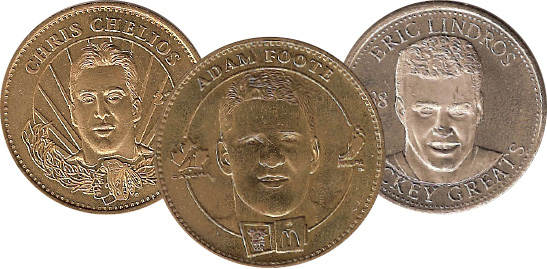
JON WALDMAN
CROSSOVER APPEAL
★ ★ ★
At various junctures, the hockey memorabilia world has intersected with other popular collecting markets.
Primarily, this has occurred in three areas — coins, stamps, and action figures (we refuse to call them dolls, of course). These hobbies have been around for decades, with hockey being part of several commemorative series. Despite the glut of product seen in recent years, coins and stamps are wildly popular in both the sport collecting world and in the niche hobby markets.
COINS
The use of metal currency dates back millenia, but coins that celebrated our beloved sport are more recent creations.
Before going too far, it’s important to establish the difference between “true coins” and other circular metal pieces. Coins refer to pieces that are actual (or at least have the markings of) currency denominations, such as pennies, nickels, dollars, and so on. Others are more often referred to “medallions”; and while they aren’t as popular with coin collectors, they have their spot in the sports world.
Medallions arguably had their biggest success in hockey in 1983, when Starter Mint Ltd. of Calgary created team-focused lines. Issued in plastic bags with a perforated “card,” the Starter coins carried a suggested retail price of $1.50 and had the appearance of a silver dollar. The faces of the coins (appropriately) featured the visage of the particular player and his name, while the reverse featured the team logo and the year of issue (assuming there was intent to create additional series).
In later years, other medallions were issued, including a popular series by card maker Pinnacle for the 1996–97 and 1997–98 NHL seasons. Named Pinnacle Mint, brass coins were paired with cards that had circular cutouts for the combined display. Rare coins in the series were even created from pure silver or gold. Other companies have created medallions over the years, including a 1998 series issued by McDonald’s for the Olympics and various series produced by The Sports Vault that were issued through newspaper promotions. In a different vein, for the 2005–06 season, American company Merrick Mint used U.S. quarters to create painted coins. In many cases, the teams depicted mirrored the state coin struck in that era (e.g. Tampa Bay Lightning player Martin St. Louis appeared on a Florida state quarter), either in the standard issue or in the gold-plated parallels.
By far, the most intricate and eye-catching coins have been created by the Royal Canadian Mint. Several themed coins have been created, including a silver dollar for the Stanley Cup Centennial. More recent years have seen the Mint strike coins that paralleled Canada Post player issues or focused on Canadian teams, depicting painted jerseys or masks. The most visible commemorative coins, however, are those that made it into Canadian circulation. In 2009, to commemorate the Montreal Canadiens’ centennial, the Mint struck a commemorative loonie featuring the Habs’ season logo. As was the case with most Mint coins, both regular circulation and commemorative, high-quality encapsulated coins were issued. The same year, leading up to the 2010 Winter Games in Vancouver, the Mint also began issuing commemorative quarters for different Olympic sports. This included hockey, sledge hockey, and a 2002 gold medal commemoration release. As was the case with the Habs coin, the Mint also had commemorative edition coins, but additionally there were 1 million coins with red colouring struck for each sport that made their way into circulation.
Over the years, other currency coins were created with a hockey theme, but these, like 50-cent pieces and silver dollars, are rarely found in change at a grocery store. Most recently, these included a 50-cent piece celebrating the return of the Winnipeg Jets to the NHL. But when it comes to hockey coins, there is nothing — absolutely nothing — that compares to the “Lucky Loonie.” In 2002, Canada put together its formidable team for the Men’s Winter Olympics tournament, with the singular focus of winning the gold medal. The Games took place in the heart of the U.S. (Salt Lake City, Utah, to be exact), and a Canadian icemaking team — led by Dan Craig — was hired for the competition. Buried at the centre faceoff dot was a loonie, and, after the Men’s team won their championship game (followed up by a gold medal victory by the Canadian women), Wayne Gretzky was handed the good luck coin by the crew. That coin made its way to the Hockey Hall of Fame, where, much like the Blarney Stone, it was put on display and was open to be touched by the public for luck. After a while, however, the coin had to be sealed off completely because the face was deteriorating from the number of rubs it received.
In subsequent international tournaments, including Men’s and Women’s World Championships and future Olympic championships, the Lucky Loonie has become a permanent part of the crew’s master plan for rink setup and has been buried in the ice, taped under benches, or stuck into goal nets. The Mint got on board with the unique story and now strikes a commemorative Lucky Loonie in both circulated and uncirculated versions before each Olympics.
STAMPS
While less common and less popular in North America, stamps are huge pursuits for collectors globally. Stamps are a bit more complicated than coins, since used pieces rarely hold any value because they’re usually marked with a postal imprint. Commemorative issues, like coins, are created and are primarily released in sheets with printer edging, with the other popular collectible format being “first day issues,” which are usually issued on a commemorative envelope.
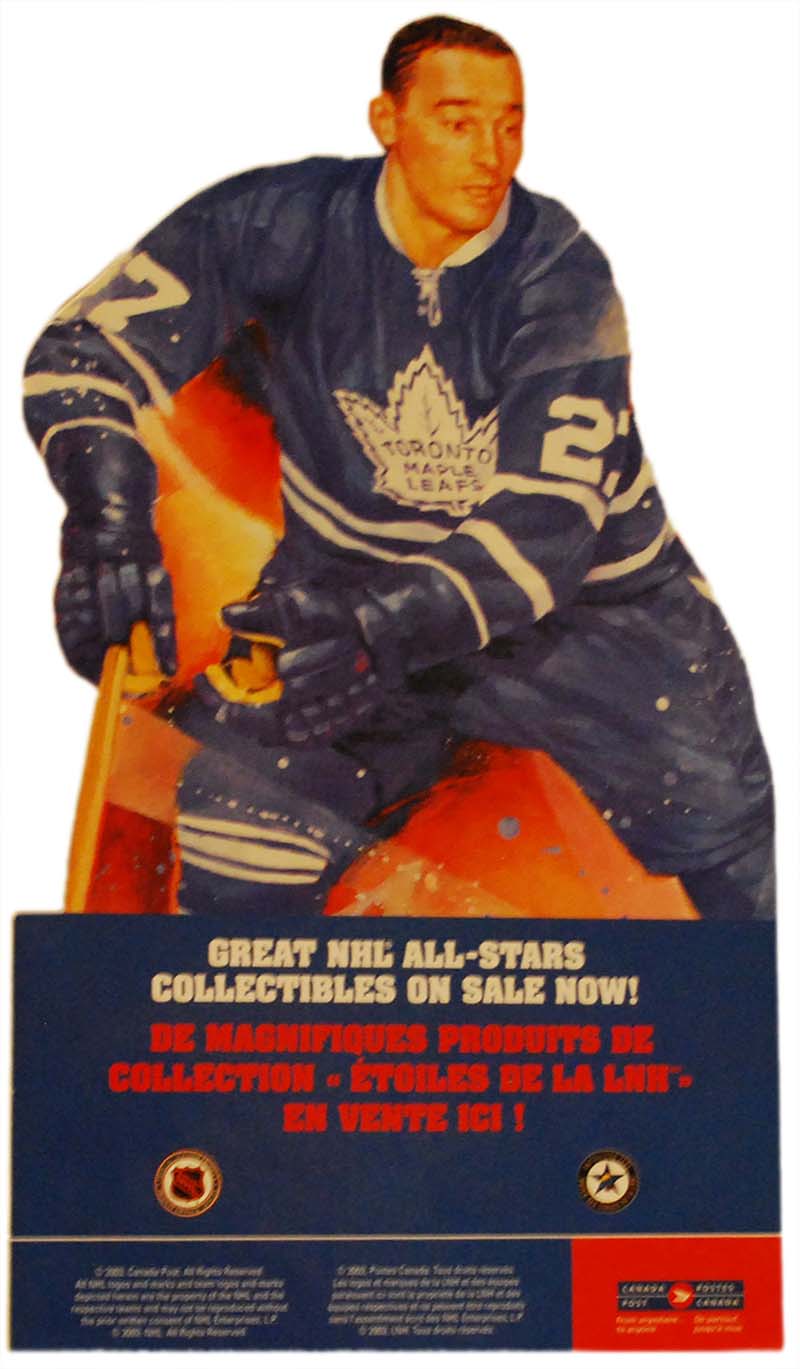
JON WALDMAN
Hockey historian Joe Pelletier, in a 2009 entry on his blog Greatest Hockey Legends, talked about the history of hockey stamps. “The first hockey-themed stamps came in 1948,” Pelletier wrote. “The Swiss issued 4 different stamps to commemorate the St. Moritz Olympics that year. The hockey stamp … featured a maskless goaltender.” Pelletier further documents that the first Russian stamp came in 1949, while Canada’s first was issued in 1956.
The NHL has teamed up with Canada Post on a couple occasions, primarily for landmark seasons such as the 75th anniversary of the league and the Stanley Cup Centennial. There was also a commemorative series issued for a four-year period that spotlighted some of hockey’s all-time legends, including Wayne Gretzky, Milt Schmidt, and Larry Robinson. During this time, Canada Post also did a barnstorming tour where players would appear at collectibles shows and Canada Post outlets, signing the stamps and assorted collectibles that accompanied them, such as commemorative prints and coin holders. While the NHL stamps were popular during their period, they pale in comparison to national team releases. Across the globe, countries have produced stamps that feature their hockey heroes (or artistic depictions of generic players), primarily around Olympics time. Some, shall we say, less ice-friendly countries fete field hockey more than our beloved cold-weather game; but northern countries like Canada, the U.S., Sweden, Finland, and Russia have all produced stamps that depict ice hockey. Pelletier noted, however, that some of these warmer-climate countries did produce Olympic hockey stamps. “In fact, countries like Mongolia have more hockey-themed stamps than Canada,” he points out. “Why? Revenue is the simple answer. Countries that don’t even know what a hockey puck is will issue stamps, almost always to commemorate the Olympics, knowing that world collectors will be buying but never using the stamps. It is no different here in North America, and it is big business.”
There’s no question, though, that the elite piece in hockey stamps does not come from Canada or the U.S. or even Egypt. Instead, it’s a Swedish issue from 1995. This particular stamp features hero Peter Forsberg, who, in a shootout, tallied the 1994 Olympic gold-medal-winning goal for the Tri Kroner. The stamp itself is beautiful as an artistic rendition of the famed overhead photo. No other stamp even comes close in the duality of commemoration and brilliance in visage.
FIGURINES
When photos and trading cards don’t give player tributes their true dimension, collectors turn to a different medium to commemorate their heroes — figurines. Either solidly built statuettes, poseable figures, or something in between, these “toys” have been a mainstay in the hobby for two decades. While one-offs like the Wayne Gretzky Mattel doll had occasionally appeared, and there were team- (but not player-) specific bobblehead figures produced in the mid-20th century, it wasn’t until the early 1990s that hockey fans had their first crack at a dedicated toy line.
In this span, from Starting Lineups to Sports Picks, we’ve seen everything from mass production and almost generic figures to true collector pursuits and detail we never imagined possible. There are also some very niche products. Witness Hallmark, for example, which for years crafted a line of hockey figurine Christmas ornaments, paying seasonal tribute to the likes of Wayne Gretzky, Mario Lemieux, and Sidney Crosby, or Elby Gifts, which created ceramic figures. There have also been regional series made, such as the famed Provigo figures of the Montreal Canadiens.
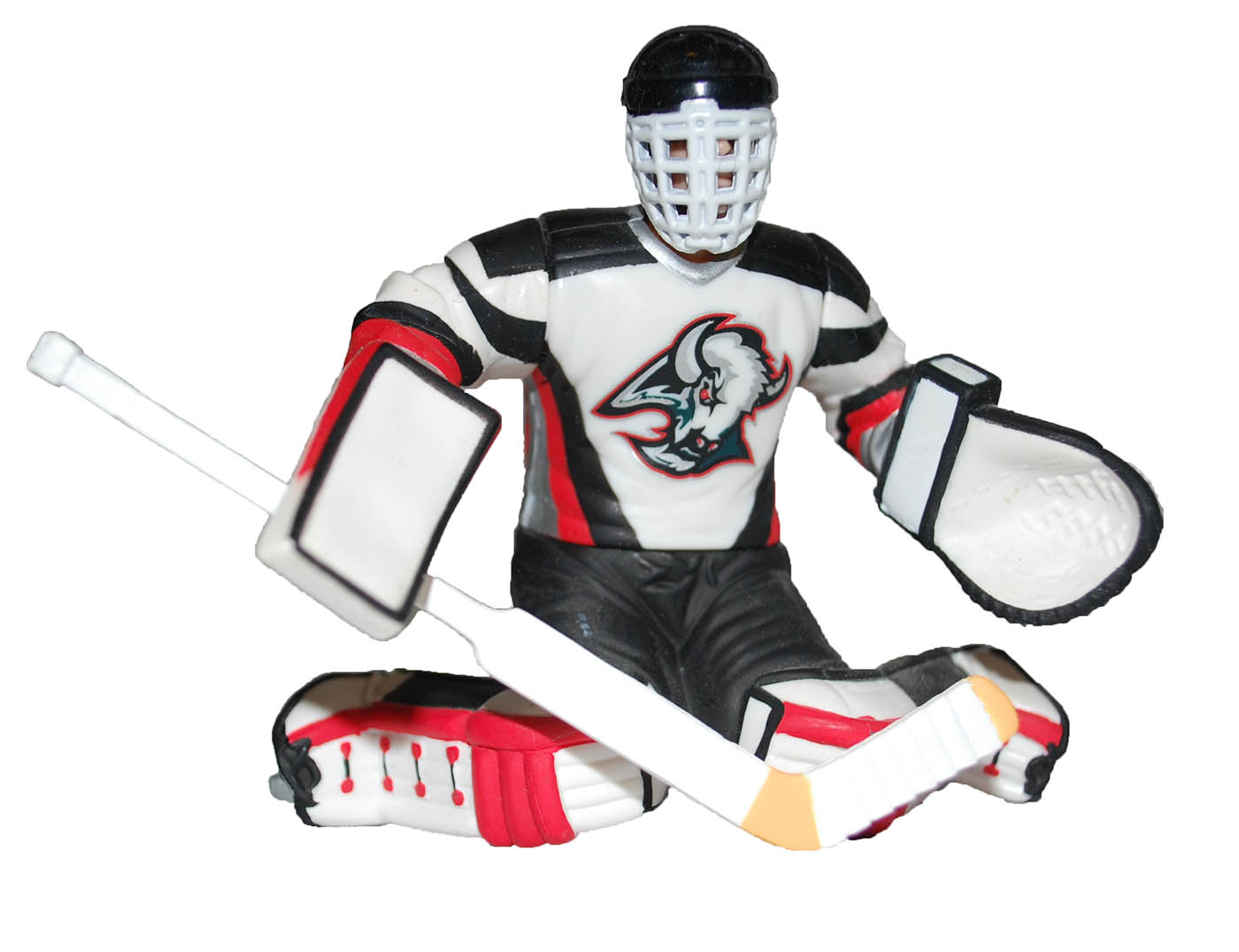
JON WALDMAN
STARTING LINEUP
Commonly known by the acronym SLU, Starting Lineup figures were produced by Kenner, perhaps best known as the toymakers of Star Wars and DC Comics action figures. In 1988, the company produced its first series of baseball players, later adding the other “big four” sports, with hockey coming in 1993. The original series featured a dozen figures, including Mario Lemieux, Brett Hull, and Ray Bourque, but there were two curiosities about that first edition: the absence of a Wayne Gretzky figure (thanks to an exclusivity deal he had with the Upper Deck Company for memorabilia); and the inclusion of two goalies, Grant Fuhr and Patrick Roy. For whatever reason, the goalie figures, especially the admittedly light-skinned Fuhr figure, became extremely popular with collectors, who immediately put a premium on these pieces over their skater counterparts.
What was unique about the SLUs was that their program included both a figure and a trading card, more often than not produced by one of the full-out sports card companies (Score, Fleer, Upper Deck, and Pacific all at one point had the coveted licence). The merger of two collectibles helped spur action in the secondary market, especially for card-crazed kids who wanted to collect those pieces almost above the figurines. This led to a collector conflict. Toy collectors, of course, are notorious for wanting their figures to be kept in packages. For the card collector new to the toy market, this meant that few of the cards would escape their packaging at first and created additional demand.
The SLU craze continued in subsequent years as more players were added to series and retired greats appeared in the multi-sport Timeless Legends series (eventually, a dedicated product line was created just for shinny). These included a Mike Eruzione figure from the 1980 Miracle on Ice squad in an Olympics-themed release. Adding fuel to the SLU fire was a series of multi-figure packs that included, for example, Brett and Bobby Hull together, show- and club-exclusive figures that demanded strong premiums over their retail-issue counterparts, figures with push-button action moves, and other unique variations. But the SLU pièce de résistance came when Kenner and Upper Deck teamed up, ushering in the opportunity for Gretzky figures to be created. Among those produced were those that depicted him holding aloft the Stanley Cup and a “Freeze Frame” boxed set that featured Gretzky in four slap shot poses, depicting him with each of his four NHL teams.
The four-inch figures, however, became victims of a changing figurine landscape in 2001. The mass production look, which did not give much detail, began to tire with collectors, especially as highly detailed pieces like McFarlane Toys figures became popular in the market. As a result of decline, Hasbro, who had taken over Kenner, made the decision to cease the product line, leaving behind a cult group of fans who to this day consider SLUs one of the best figure lines in all of sports.
BOBBLEHEADS
No one has ever successfully explained the allure of the bobblehead. They’re more often comical recreations than actual portrayals and … well … their heads move. Okay, they’re absurd; yet somehow the figures continue to be popular, especially when it comes to giveaway nights at hockey arenas.
The first run for bobbleheads came in the Original Six era and were far cries from the figurines we see today, resembling tubby boys instead of athletic professionals. The kitsch appeal of these figures lived on for several years, and even now, in an era when realism is in demand, the chubby original bobbles can be found in high demand at auctions, while newer versions — including customized figures — have their own following.
But the bobblehead story doesn’t end in this initial phase. In the early 2000s, the bobblehead enjoyed renewed interest from collectors. Quickly, two manufacturers bobbled their way to the top of the toy world — Alexander Global Promotions and Forever Collectibles — and licences were snatched up quickly. NHL, AHL, junior leagues, international … you name it. If you wanted a bobblehead of your favourite player, you had easy access. The peak for the figures came in 2002 and coincided with the Winter Olympics. At that point, Alexander Global created bobbles of both Team Canada and Team USA. The Canadian figures were quickly swept off of store shelves by a nation rabidly backing their boys in their pursuit of the first Olympic gold in 50-odd years. The U.S. figures, meanwhile, were only available at the Games themselves. In the end, there were three versions of the Canadian figures released: one with a white base, one with a gold base, and one that featured the players — and team execs like Wayne Gretzky — with gold medals around their necks.
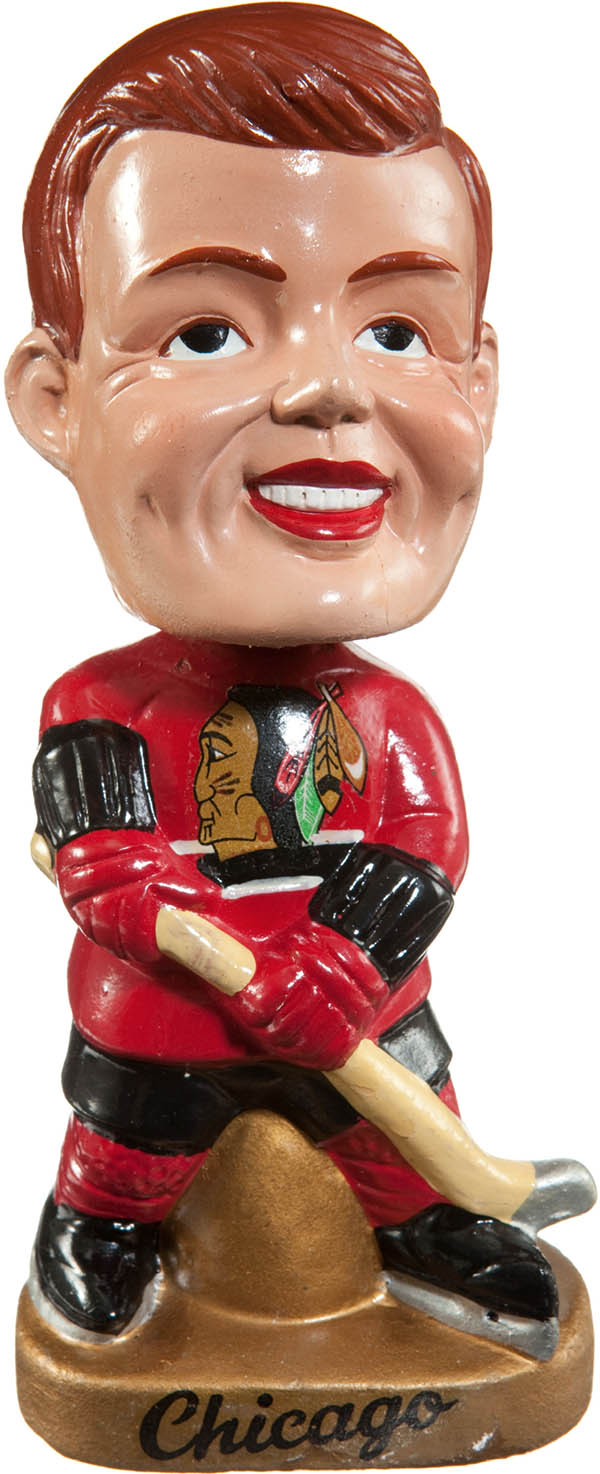
HERITAGE AUCTIONS
Even after the Olympics, bobbles continued to be popular; partnerships with trading card companies led to more exposure for the toys. But like so many other trends in sports collectibles, the bobblehead craze eventually died off and retail outlets were left with a huge amount of inventory. Where stores had trouble with the figures, hockey arenas found them to be a smashing draw for fans. Bobblehead giveaway nights became signature events on the schedule for teams of all competitive levels as highlight players and team mascots were highly coveted. Today, these regional pieces are exceedingly in demand on eBay as collectors attempt to barter with cohorts outside their area and add that head-shaking (in a good way) piece to their collections.
SPORTS PICKS
The appeal of the figures created by Todd McFarlane — perhaps better known as the man who brought Spawn, one of the greatest antihero comic book creations, to the world — is best explained by one of his subjects.
“It’s the definition and the way they really approach it,” explains Marcel Dionne, who was not only in the Legends series but was a key cog in the agreement that brought the first legendary figures to market, acting on behalf of the Hockey Hall of Fame. “Everything has to be approved, and the likeness has to be close. There’s only so much you can do, but I thought it’s pretty good. If you look at it, they also don’t really flood the market. They make it so the collector can really enjoy this.”
This attention to detail came from Todd McFarlane’s own frustrations with what had been previously produced. “If you collect bubblegum cards and you look at any card, everything’s there,” McFarlane said in a 2002 interview, “and then all of the sudden, because I have to take that thing from 2-D to 3-D, the stick can’t be in proportion, you can’t have the logos right, you can’t have the markings? All of a sudden you have to start taking away from the reality of what I see on TV and enjoy? A lot of other collectors didn’t have a problem with it, but I did. If we’re going to do sports, then, damn it, we’re going to do it right. If it doesn’t look like the guy, then what are we doing it for?”
The debut of McFarlane’s statuettes came amid the decline and eventual cancellation of the Starting Lineup series. Standing in the neighbourhood of six inches, the first series of McFarlanes depicted NHL superstars like Steve Yzerman and Patrick Roy in sendups of their uniforms and were solely licensed by the NHLPA. It took one other series of realistic figurines before McFarlane was able to convince the NHL that they were worthy of the coveted licensing contract. Agreements were also made with equipment manufacturers and even the goalie mask artists.
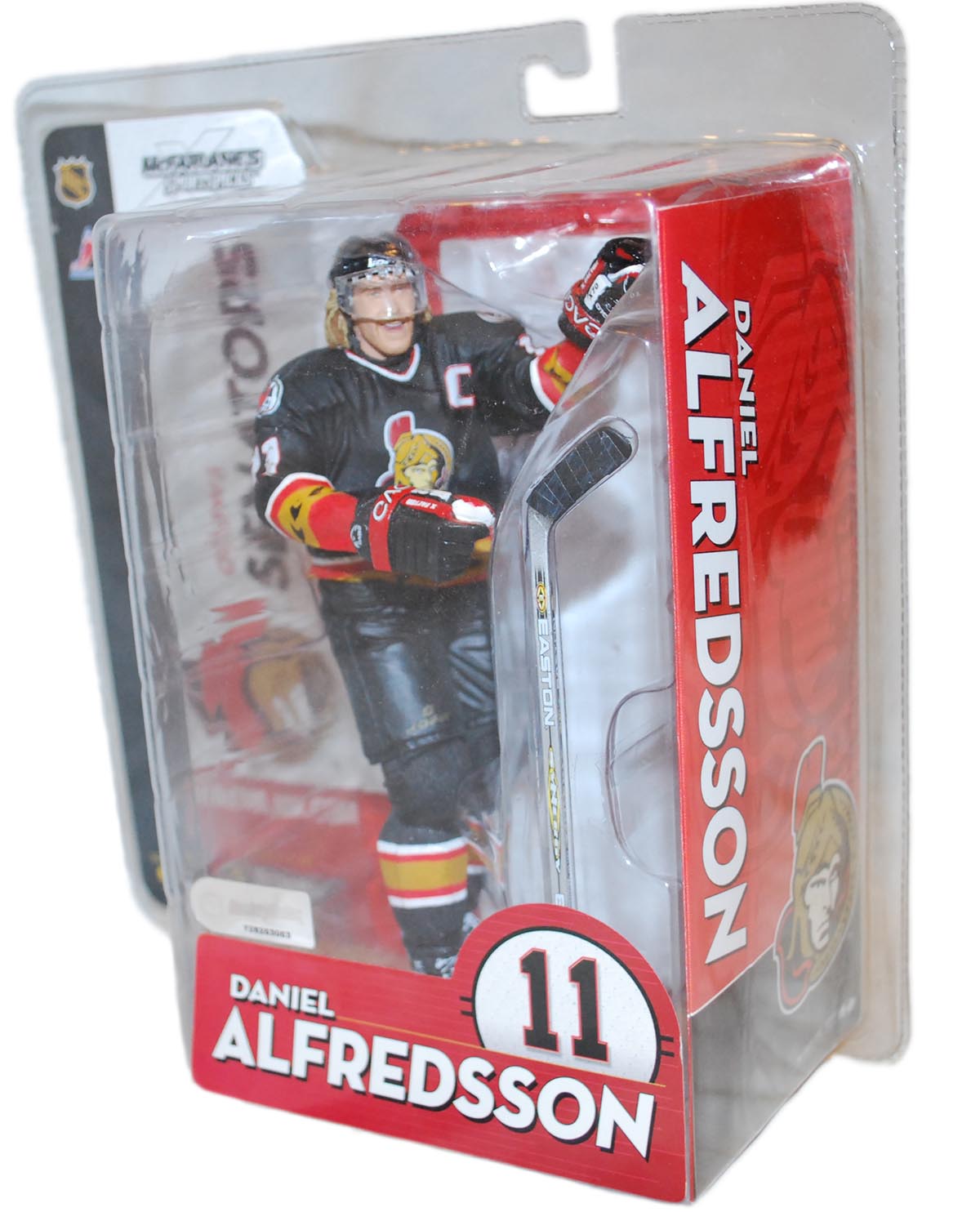
JON WALDMAN
In a flurry, series were produced that commemorated current and past stars from hockey. Virtually every name player (and a few not-so-name players) have been part of the Sports Picks lines. Some truly creative pieces have been issued, including players jumping over the boards, hat-trick celebrations that include mini ball caps on the ice, and Stanley Cup hoists.
In recent years, Sports Picks has seen a decline in popularity as other trends catch collector eyes, but the company continues to soldier on with popular lines that have included Olympic heroes and autographed figures.